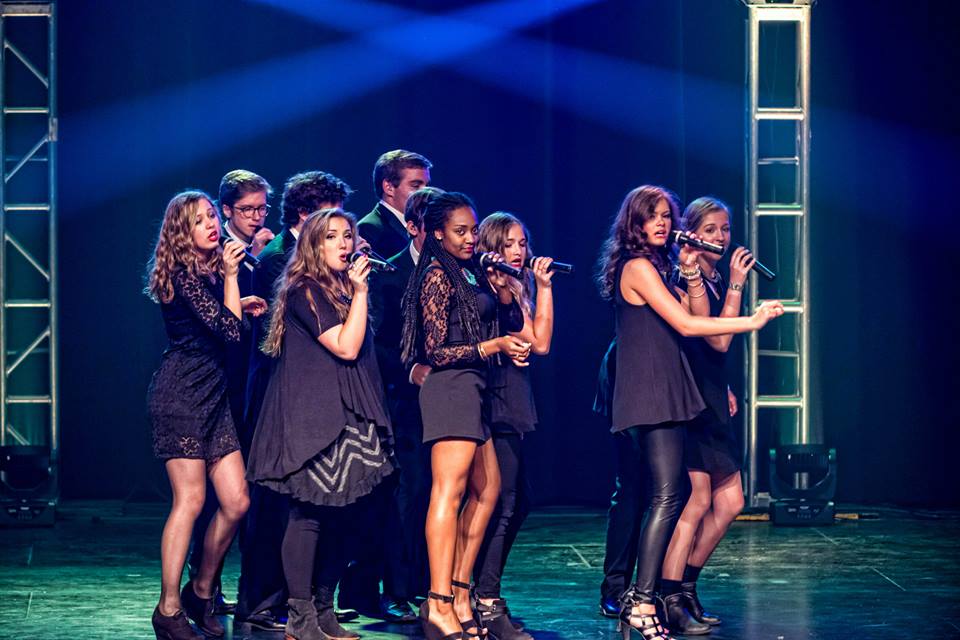My last post about standing in a semicircle provoked quite a bit of conversation! Many people brought up great points in defense of the formation for things like choral works and homophonic charts (which I completely agree with). Others thought that movement outside that traditional formation was only possible with wireless microphones and in-ear monitors (not true…you can use them for zone mic setups and acoustically).
Perhaps the best question I got from that article was, “Well, J.D., if there are better ways to visually present contemporary a cappella, then what are they?”
I’m a visual/kinesthetic learner, so let’s look at a couple of examples:
Who You Are, Briarcrest OneVoice, arr. Ben Bram, Katherine Ann Mohler & Chandler Booth, Soloists
- 0:00 – At the beginning, the singers are scattered around the stage, fairly spread apart from each other. They are facing at various angles towards the soloist, who is center upstage. A couple of girls are sitting downstage for varying texture.
- 0:47- At the chorus, the soloist takes a few steps downstage. Over the course of the first chorus, each singer gradually turns to the audience. They remain planted and stoic.
- 1:20- At the downbeat of the second verse, the singers all plant together with the entrance of the vocal percussion. Notice also that the soloists make eye contact and an emotional connection when switching places (note: I only like changing soloists when it helps make the music better, never for “fairness” or “equality”).
- 2:00- Second chorus, more VP, singers sway back and forth with the beat. They are subtly moving closer to the soloist, as well. This allows them to create the movement at the bridge.
- 2:28- Bridge, the most movement of the piece, as the bridge serves its normal purpose of transformation in the song. Often, because the bridge serves this purpose, the music is also less harmonically and rhythmically stable or consistent with the rest of the song. For these reasons, I feel like bridges are logical places to change things up visually.
- 2:59- Last chorus, the classic downstage rush into the straight line. This can be very powerful when used sparingly. Like anything else, it also works best in contrast. By limiting the use of the downstage area for most of the song, it heightens the contrast of the edge of the stage position of all the singers at the end.
I owe the simplicity of this staging to master choreographer Randi Kleiner!
Half the Man, arr. Robert Dietz, Hannah Gray, Soloist
- 0:00- Soloist is downstage center, everyone else is in a semicircle behind her (gasp!). They are facing each other, not the audience.
- 0:29- Coinciding with the downbeat of chorus 1, the semicircle turns and faces forward.
- 1:26- Soloists start to sway with entrance of steady VP (you caught me– one of my consistent tools!).
- 1:38- BGVs cross stage positions and move slightly downstage. They are now in homophonic “instrument” groups. The two higher voices who will sing harmony with the solo on the last chorus are strategically placed slightly behind her to her left and right.
- 2:23- The bridge on this song, while transformative emotionally, is more reserved. Therefore, the singers pull in so they can eventually uncoil like a spring, releasing the emotional energy with the last chorus.
- 2:55- Okay, maybe I’m more predictable than I should be, but when a downstage rush line works, it works!
Special thanks to Rachel Chaloub, videographer extraordinaire, for capturing this footage at Kettering AcaFest. Featured photo credit: Steve Austell
Those are just a couple of examples of easy, effective staging for an a cappella group. I’ll post more soon.
In the meantime, if you have great examples of your group, post them in the comments below!

